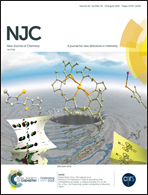Boron-doped graphitic carbon nitride as a novel fluorescent probe for mercury(ii) and iron(iii): a circuit logic gate mimic†
Abstract
The detection and determination of metal cations in different real samples are important matters in various fields of experimental science. Herein, graphitic carbon nitride (g-C3N4) doped with boron was facilely prepared and shown to be a practical fluorescent probe for the detection and measurement of mercury and ferric ions in real samples. The nanomaterial was characterized by XRD, FT-IR, SEM, elemental mapping, and N2 adsorption–desorption techniques. Fluorescence of the boron-doped g-C3N4, with a 280/348 nm excitation/emission maximum, is quenched by mercury and ferric ions. The quenching effect was used to design assays with detection limits of 185 nM (for Hg2+) and 154 nM (for Fe3+) and worked in the pH range 7–10, in aqueous solutions. The mechanism of quenching was investigated by using the Stern–Volmer equation. The probe was used to determine the Fe3+ and Hg2+ levels in spinach and tuna fish, respectively, and the results were compared with ICP-OES. Quenching by Fe3+ can be reversed by sodium hexametaphosphate (SHMP), as a masking agent for Fe3+. Therefore, a circuit logic system was developed with Fe3+, Hg2+, and SHMP as inputs, and the quenched signal as the output.



 Please wait while we load your content...
Please wait while we load your content...